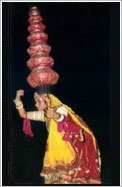
Bhavai(Strolling Players) is a popular folk theatre form of Gujarat. Veshas(means costume) or Bhavai plays are also known as swang. The origin of Bhavai goes back to 14th Century.It is said that Hemala Patel's(a resident of a village called Unza) daughter Ganga was kidnapped by a Muslim Subedar. Their family priest Asait Thakar, a resident of Siddhapur, rushed to the subedar claiming Ganga to be his own daughter.Subedar asked Asait Thakar to eat with Ganga from the same plate to prove that she is really his daughter. Asait did that but for this he incurred the ire of his own caste men and was excommunicated as he had taken food with a low caste Ganga. He started earning his living by performing plays which later came to be known as Bhavai.
The caste of the performers of Bhavai came to be known as tragala.In one of his long poems Asaita has given the date of the composition as AD 1360. Thus it seems that Bhavai as a dramatic form emerged in the late 14th century.Asait wrote about 360 plays, out of which some 60 have survived. Some of these veshas bear his name. It is clear from the bhavai performance that this form must have evolved from the earlier known forms of folk entertainment. The word Bhavai in the sense of a show or spectacle occurs in the 13th century Apabhramsa Jain religious verse. It says: "In a tree-less tract even a bunch of eranda(caster oil plant) makes a good show (Bhavai)." Abul Fazal’s Ain-e-Akbari also mentions Bhavai while mentioning some communities.
Bhavai is as much a form of entertainment as it is a kind of ritual offering made to Goddess Amba. In the courtyard of the Ambaji temple near Mount Abu the Navratri festival is celebrated with Bhavai performances. Amba is the presiding deity of Bhavai. Bhavai according to some scholars is made up of two words- Bhava and Aai. Bhava means universe and aai is mother, together it means mother of the universe, Amba.
Subtle social criticism laced with pungent humour is the speciality of Bhavai. The pompus and incongrous behaviour of the high caste people is scoffed at in Bhavai. Probably the anger over injustice suffered by the originator of Bhavai, Asaita Thakar, got permeated into the art of Bhavai. Some of the Bhavai plays present a scathing review of the caste-riden social structure. People belonging to different levels of social strata ranging from king to knave are portrayed in Bhavai.
Bhavai Veshas protray people from all classes of society. The barbers, knife-sharpeners, robbers, bangle sellers and social and economic thieves, banjaras, odas, fakirsand sadhus, darjis. There is a Vesha depicting the story of ansuccesful love affair of a Bania woman and a Muslim Thanedar. At the end of the play Jasma Odan, a Muslim fakir appears to whom people request to revive Jasma.
Humor plays a vital part in any Bhavai performance and comes into play even while dealing with mythological personages. This predominance makes Bhavai unique among the traditional arts of India.
The chief of the Bhavai troupe is called Nayak. He first marks the performing arena, then offers kumkum to the oil-torch which is a symbol of goddess Amba and sings prayer songs in her praise. Then enters an actor covering his face with a plate, he is Lord Ganesha, the remover of obstacles. Goddess Kali is the next to enter and after she departs comes the Brahmana.After these preliminary appearances the Vesha actually starts.
The Nayak and the jester always remain on the stage directing the course of action with their commentary and intervention. Through songs, dialogues, speeches in prose and verse the story unfolds. There is lot of dancing and singing in Bhavai. Female characters are acted by men.
The language of Bhavai is a blend of Gujarati, Hindi, Urdu, and Marwari. Veshas were published for the first time in the nineteenth century. Past performances were linked to their predecessors through practice and the oral tradition.
The bhungal is a four feet long copper pipe that provides a strong note and is unique to Bhavai. The bhungals are played during dance sequences and otherwise to indicate important characters. Other musical instruments that form part of Bhavai are the pakhwaja (drums), jhanjha (cymbals), the sarangi (a stringed instrument), and the harmonium. The style of music is always Hindustani interspersed with local tunes.
 Bhavai is also prevalent in Rajasthan as a folk dance comprising of a spectacular performance. The Dance form consists of veiled women dancers balancing upto seven or nine brass pitchers as they dance nimbly, pirouetting and then swaying with the soles of their feet perched on the top of a glass or on the edge of the sword. There is a sense of cutting edge suspense and nail biting acts in the dance.
Bhavai is also prevalent in Rajasthan as a folk dance comprising of a spectacular performance. The Dance form consists of veiled women dancers balancing upto seven or nine brass pitchers as they dance nimbly, pirouetting and then swaying with the soles of their feet perched on the top of a glass or on the edge of the sword. There is a sense of cutting edge suspense and nail biting acts in the dance.Wikilink
4 comments:
Hi,
It was a nice article. You are a good writer; would like to see more of your posts.
UBO nodtha nodtha avara dance form bagge researchaa?
neen en maadthidyappa..?? nidde hod du hod du.. research article bariyoda...??
hmmm........well an in-depth article.
but then these ''folklore'' are dying out and whether they survive in the next century is anybody's guess!
Post a Comment